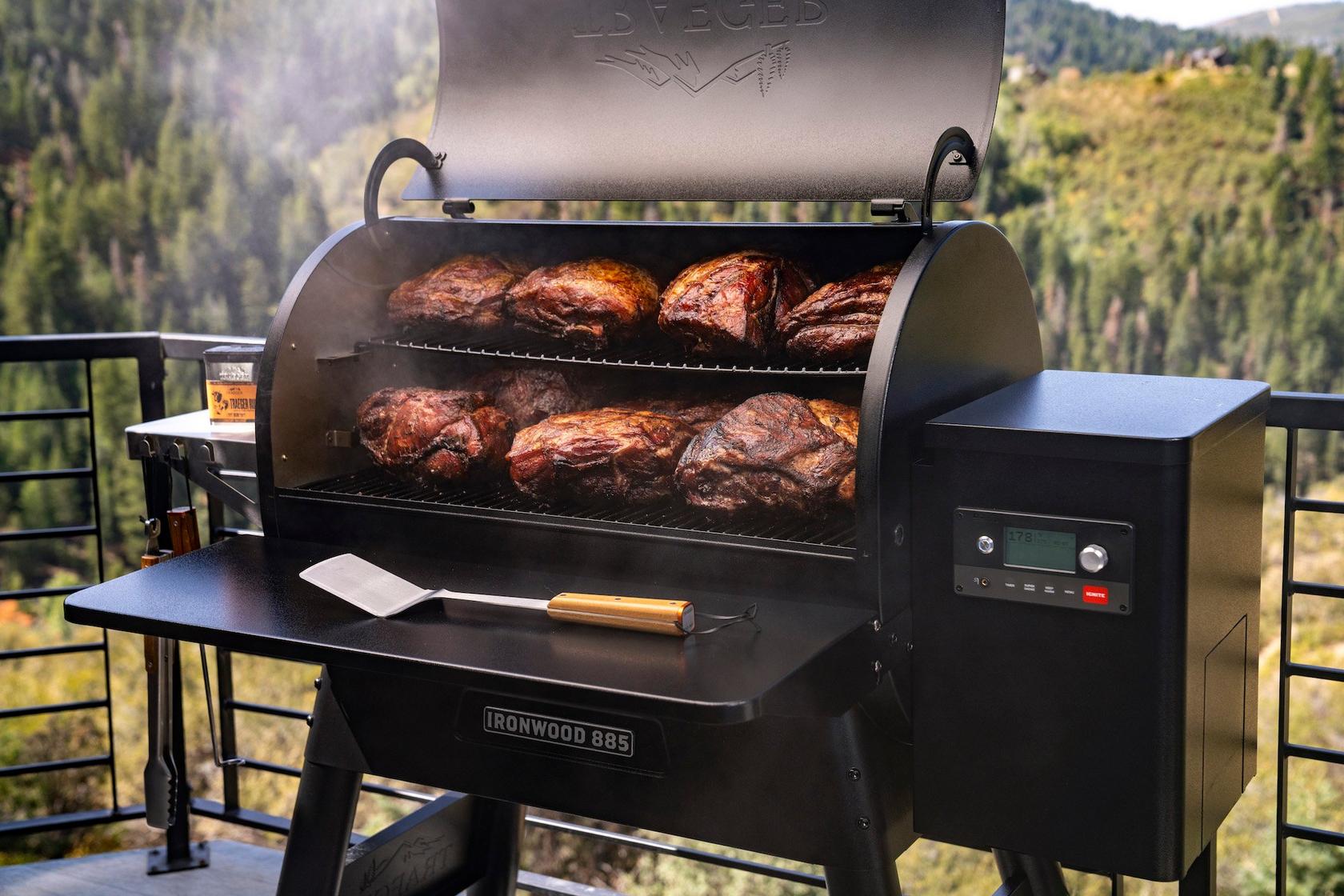
Smoking is an ancient method of preserving meat. If you go far enough back in your family tree there’s a master smoker in there somewhere -- whether they smoked salmon on the Pacific Northwest coast, beef in Armenia, or pork sausage in Germany. Farms in colonial America had special buildings for smoking (called smokehouses) where vast quantities of pork, fowl, and other large meats were cooked and preserved.
Today, manufactured backyard barbecue smokers are a popular way for home cooks to create this delicious old-time flavor.
How Does a Barbecue Smoker Work?
A barbecue smoker cooks food through the process of convection. Hot air, created by burning wood or wood pellets, surrounds the food and slowly heats it to the desired temperature. In addition, natural smoke from the burning wood adheres to the surface of the meat, providing delicious natural wood flavor.
Modern smokers -- like Traeger wood pellet grills -- use fans to circulate the heat and cook food faster and more evenly.
Before first use, smokers must go through a process called seasoning. The empty smoker is brought up to high heat for 45 minutes or more, to burn off oils from the manufacturing process that might affect the flavor of smoked food. The exact process depends on the type and size of the smoker.
What Is the Best Smoker for a Beginner?
A Traeger wood pellet grill is the best smoker for a beginner because it delivers consistent temperature and smoke flavor. Other smokers require near-constant monitoring of the wood fire to maintain the proper cooking temperature. With a Traeger, you simply set the temperature and the smoker does the rest.
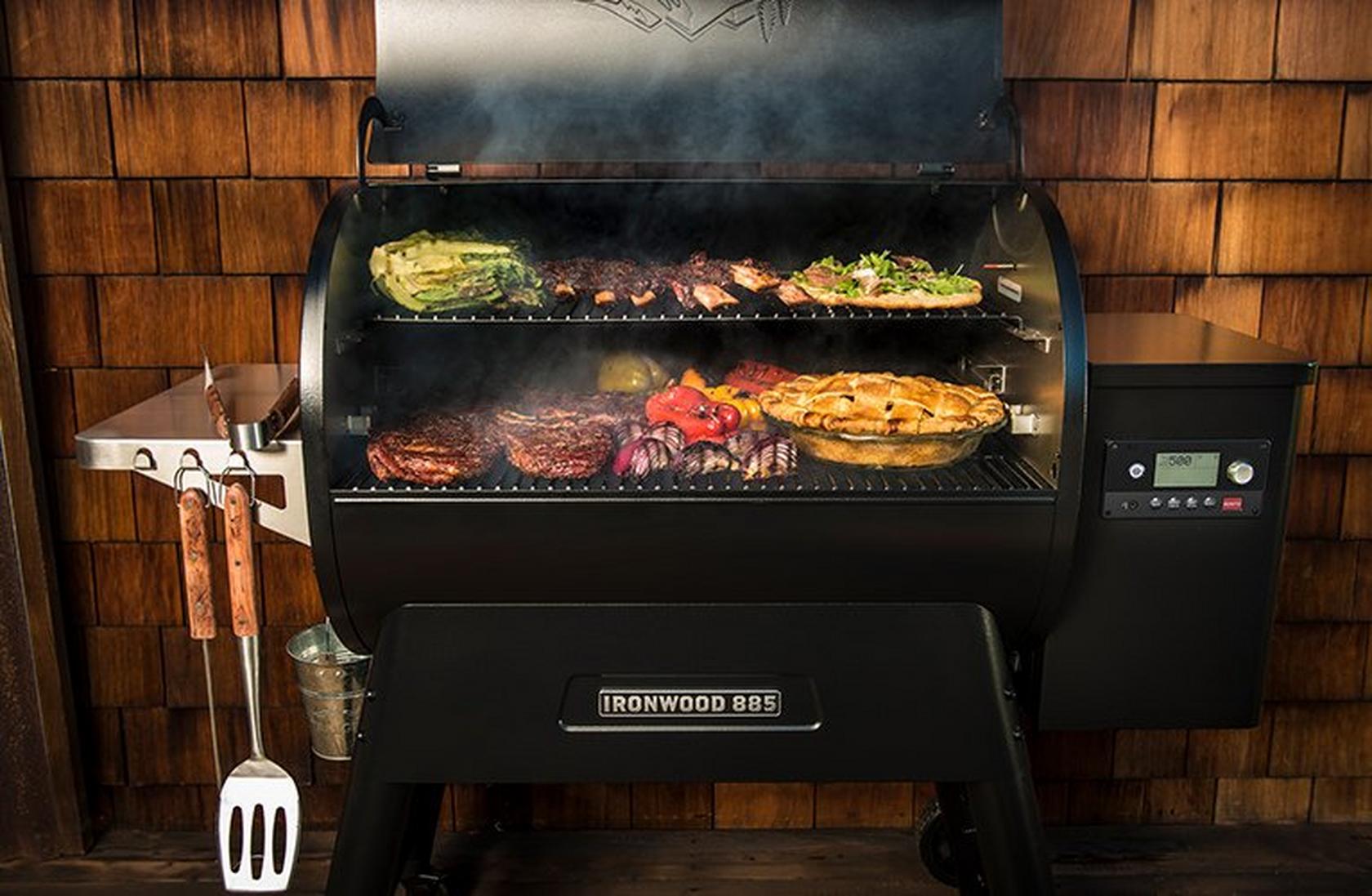
What Is a Barbecue Smoker Used For?
A smoker is primarily used for low and slow cooking of large cuts of meat like brisket, pork shoulder, and prime rib. Some smokers, like a Traeger, can also be used for direct grilling of smaller cuts, like chicken breast, or for cooking vegetables. A Traeger wood smoker can cook low and slow or at high temperatures.
What Are the Different Types of Barbecue Smokers?
The smoking process is fairly simple: Deliver smoke and heat to food. The two key parts of every smoker are the fire box, where the combustion of wood happens, and the cooking area, where the food absorbs the smoke and heat that both cooks and flavors. Here's how the most common types of smokers stack up.
Pellet Grill

A pellet grill or pellet smoker uses electricity to evenly burn standard-sized wood pellets within a fire box. Pellets poured into a hopper are automatically guided to the fire box, where they burn and add wood-smoked flavor to food. Fans circulate the heat and smoke for consistent, even cooking.
Pellet grills are designed to deliver the exact cooking temperature needed which makes smoking easy.

Offset Smoker
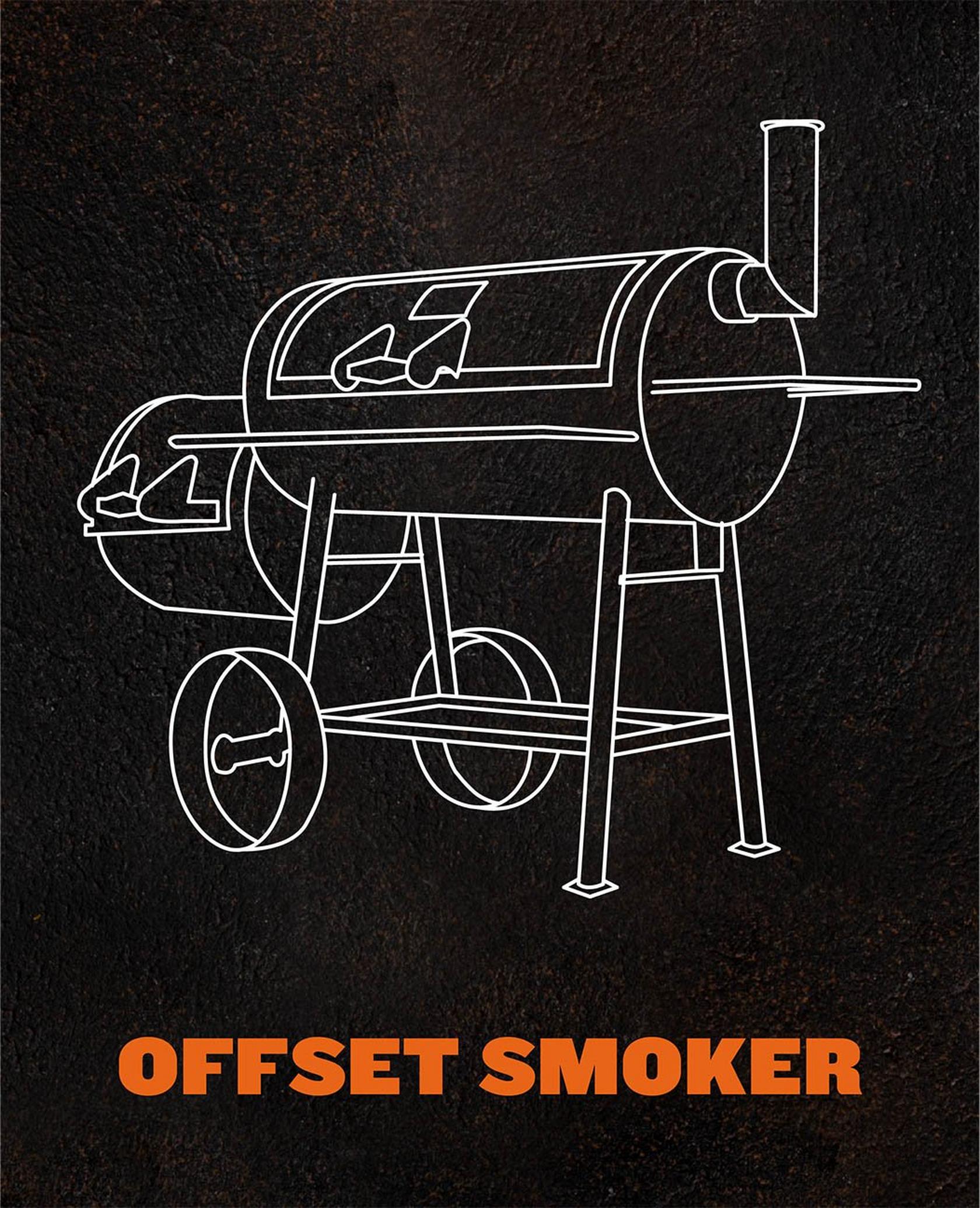
The offset smoker is the most common smoker design. The smoker's two main components are the fire box and the larger cooking area. In the fire box, wood, charcoal (or a combination of both) are burned. The heat and smoke from the fire box is channeled to the cooking area.
The fire in the fire box must be constantly watched to make sure the right amount of heat and smoke is going to the cooking area. If the fire burns too hot, the food might cook too fast. If the fire doesn't burn hot enough, the food may take hours longer to cook than expected.
Vertical Water Smoker

Vertical water smokers (sometimes called bullet smokers due to their shape) have three parts. On the bottom is a fire box where charcoal and wood are burned to generate heat. On top is the cooking area where food is placed. In between the fire box and the cooking area is a water pan. The water acts as a barrier between the heat and food which helps keep the temperature at low-and-slow levels. Vapor from water evaporation also maintains moisture within the smoker and can help keep meat from drying out.
The fire requires constant attention so the smoker doesn't get too hot or too cold. If you want to add smoke flavor to the food, you must periodically add wood chips to the fire box.
Cabinet or Box Smoker

The cabinet or box smoker is the smoker of choice for people who like to be organized. The heat source can be either electric, gas, or charcoal, depending on the model. The food is placed on sliding trays within the unit — much like a cabinet. This design maximizes the space available for smoking.
Most cabinet smokers can't be set up for grilling. And adding smoke is up to you — you'll need wood chips or chunks to get the smoke flavor.
Drum Smoker

A drum smoker, also called a barrel smoker, is a good way to cook a lot of meat at once. The smoker has an area for charcoal at the bottom. At the top of the smoker, there are hooks to hang cuts of meat like ribs or whole chicken. The charcoal fire must be kept at the proper temperature which requires near constant monitoring. Also, wood chunks or chips must be added if you want any natural wood smoke flavor.
Smoker Oven

A smoker oven is an electric barbecue smoker more often found in professional kitchens than private homes. The temperature is regulated electrically while wood chips or chunks in a smoke box provide the natural smoke flavor. A smoker oven can cost tens of thousands of dollars and may require a special electrical hookup.
While a smoker oven delivers natural wood flavor like a pellet grill, the quality of the smoke will depend on the quality of the wood you use. Not all wood will deliver consistent smoke. With a wood pellet grill using Traeger pellets you get consistent smoke flavor every time.
Kamado Grill / Ceramic Smoker

Similar to the vertical water smoker and the barrel smoker, a kamado grill or ceramic smoker has a fire box at the bottom and cooking area on the top. The major difference is the ceramic construction. Ceramic is a good insulator so a small amount of charcoal will go a long way. However, you still need to monitor the fire to keep it at the proper temperature, and you must add wood chips or chunks to get a natural smoke flavor.
What Are the Pros and Cons of a Barbecue Smoker?
The best thing about a barbecue smoker is it’s designed for low and slow cooking and delivering natural wood flavor to food.
You can use other types of grills for smoking, but devices designed for the process provide the best results.
There are a few downsides to most barbecue smokers:
- Finding a reliable source of dried wood logs or chunks to provide fuel for the smoker.
- Building and maintaining a fire for hours and even days in order to fully cook the food.
- Disposing of burnt embers, and other time-consuming cleanup tasks.
Fortunately, a Traeger wood pellet grill/smoker solves these problems. Traeger provides all-natural, flavor-packed wood pellets that provide a consistent temperature and burn clean and in addition to being a smoker, you can also grill, BBQ, bake, braise, and roast.
What Do You Need to Grill on a Barbecue Smoker?
Not all smokers are built for grilling. Smokers are designed to deliver indirect heat at low temperatures, while grilling requires direct heat at high temperatures. Some smokers, like wood pellet grills and ceramic smokers, can also be used to generate the high temperatures needed for direct grilling.
How to Use a Barbecue Smoker
Every smoker is different, and barbecue experts all have their own favorite methods. What follows is a broad overview of the steps for smoking.
How to Start a Barbecue Smoker
To start a traditional smoker, you build and ignite a combination of wood and charcoal in the designated fire box. Once the cooking area reaches the desired temperature, the food is added. More charcoal or wood must be added during cooking to keep the temperature up.
For a wood pellet grill, you simply turn on the unit, the smoker heats up to the desired temperature, and you add the food.
How to Put out a Barbecue Smoker
Part of the process of using a traditional barbecue smoker is waiting for the fire to go out. You can help put out a fire by depriving it of oxygen. Close the lid and shut any open vents. Never pour water over the flames or embers as it will cause your smoker to rust.
Wood pellet smokers are different. There is no open flame, simply a combustion process that can be stopped at any time by switching off the smoker.
How to Clean a Barbecue Smoker
Grease, oil, or charcoal buildup in your smoker is inevitable and eventually will add unpleasant flavors to the food you smoke just like any other type of grill.
It's a good idea to remove ash build-up and wipe down any obvious patches of oil after every smoking session -- once your smoker has cooled down and it is safe to do so, of course. Removing wood or charcoal embers after every use will also extend the life of your smoker.
You should also do a periodic deep clean, cleaning the interior and exterior surfaces and re-seasoning the grill, as described above. Smokers have different materials and specifications, so consult the smoker manufacturer for instructions.
What Can You Cook on a Barbecue Smoker?
Brisket
Brisket is a cut of beef that can be smoked, then served in slices or chopped. We suggest using apple wood, which like most fruit woods, adds a hint of sweetness.
For the best smoked beef brisket, we recommend smoking at 225 degrees Fahrenheit until the internal temperature of the meat reaches 204 degrees. This process will take 8 to 10 hours.
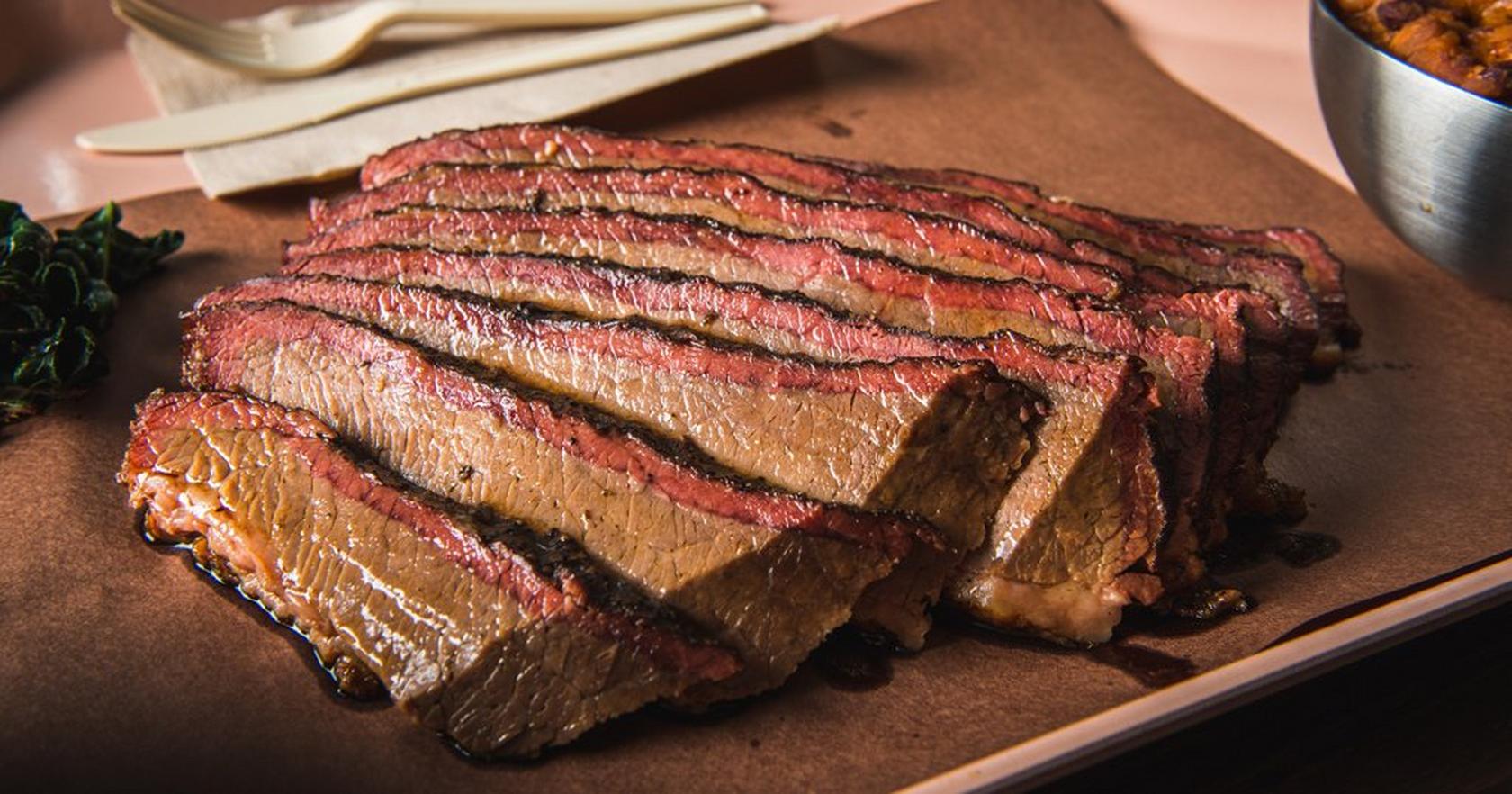
Steak
Steak is usually grilled over direct heat, but you can smoke steak, too. Smoking steak works best on a wood pellet grill that can be set for either low or high temperatures. We suggest using our Signature pellet blend, a subtle addition that lets the steak's flavor come through.
For the best smoked steak, we recommend smoking at 225 degrees Fahrenheit until the internal temperature of the steak reaches 115 degrees for 35 to 45 minutes. Then, remove the steak and increase the temperature of the smoker to 500 degrees. Once that temperature is reached, return the steak to the smoker and cook 3 to 4 minutes per side until the internal temperature reaches 135 degrees.
Chicken
When done on a smoker at low temperatures, chicken is usually cooked whole. This allows the necessary time for smoke flavor to penetrate the skin and meat. We suggest using mesquite wood pellets; the classic flavor of Texas barbecue.
For the best smoked chicken, we recommend smoking at 225 degrees Fahrenheit until the internal temperature of the thickest part of the chicken breast reads 160 degrees. This will take 2.5 to 3 hours.
Fish
Butterflied or filleted fish make for a simple and delicious smoking project. We suggest using oak wood because it’s a light flavor that won't overpower the fish. The fresher the fish, the better the flavor will be.
For the best smoked fish, we recommend brining for at least one hour. Then smoke at 225 degrees Fahrenheit until the fish starts to flake. This process will take 1 to 3 hours depending on the size of the fish.
Turkey
Smoking a whole turkey will make for a Thanksgiving you'll always remember. We suggest using our turkey blend, a blend of oak, hickory, maple, and natural rosemary flavor. Smoking turkey is a long process, and having a wood pellet grill gives you the option to speed up the cooking time by switching from low and slow to a roasting temperature.
For the best smoked turkey, we recommend brining the bird overnight. Then smoke at 225 degrees Fahrenheit for 3 hours. This will ensure a deep, natural wood smoke flavor. Increase the temperature to 350 degrees, and roast for 3.5 to 4 hours until the internal temperature reaches 165 degrees Fahrenheit in the thickest part of the breast.
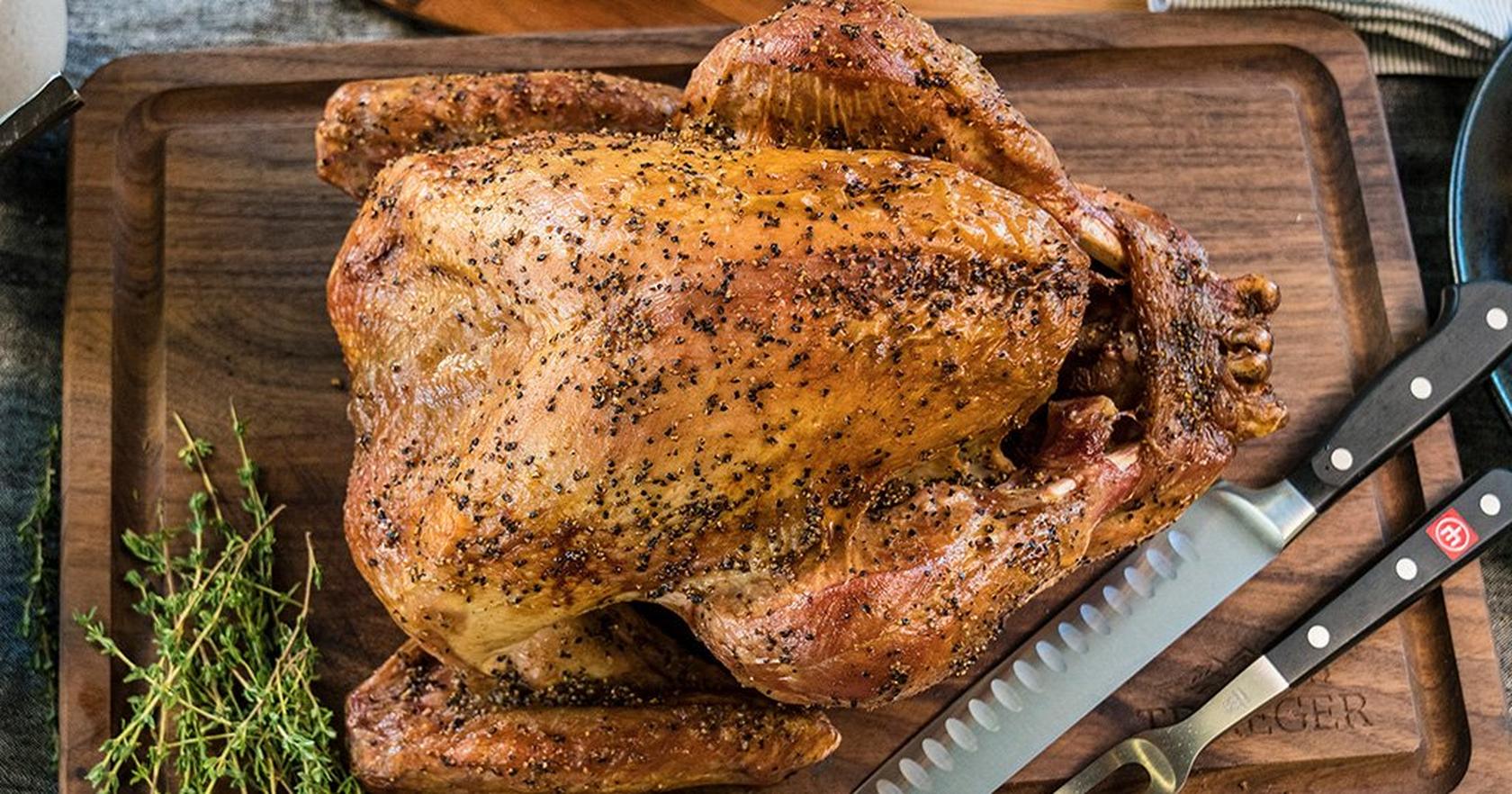
Building a Barbecue Smoker
All you really need for a "smoker" is an area to build a fire and an area to cook the food. Some people even turn metal trash cans into smokers. Another classic DIY version is repurposing a 55-gallon drum, with an attached smoking box, to create an offset smoker.
Building a barbecue smoker won't cost as much as buying a new one, but there are drawbacks:
- Materials that aren't designed for cooking food may have harsh coatings or chemicals that could harm you or your family.
- The airflow between the fire area and the cooking area is the most critical part of successful smoking.
Modern Technology That Helps You Connect With the Past
The invention of smoking helped our ancestors survive cold winters and lean harvests. It's no wonder that natural wood smoked meat seems to stir us in ways that other food preparations don't.
In our busy modern lives, smoking is usually something we are trying to fit into our other commitments. So modern smoker manufacturers have found a way to make things easier with advanced temperature control, clean-burning wood pellets, and powerful fans that increase smoke and heat. At Traeger, we design our grills to give you maximum control over the process, and make smoking as fun and hassle-free as possible.